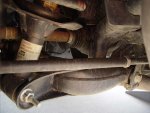nwoods
Expedition Leader
RoverRandom, what are the part numbers for the OME springs?
Kevin, the guy with the factory coiler bought from Nathan Woods pictured above was sourcing springs from Australia because no one in the states had a kit last year. It definitley sat too low with the factory springs especially loaded for the trail.
If I got an LR3, I would convert to coils but your lift is limited by control arms and axles. Sorry, IFS guys...
This is a curious comment. I gave Kevin three sets of springs. The OEM factory springs (soft), +40mm lifted springs from Peddars in Australia that were soft, but not OEM soft, and then rock hard +65mm springs from King Springs also of Australia. It had the KingSprings installed when I sold it to him.
As others have commented, this factory springer had all the various traction control systems (DSC, SRS,TC, etc...), but did not have the Terrain Control to integrate them. You had to use a bit of intelligent right footwork












